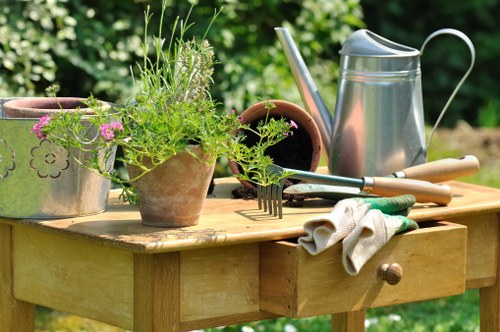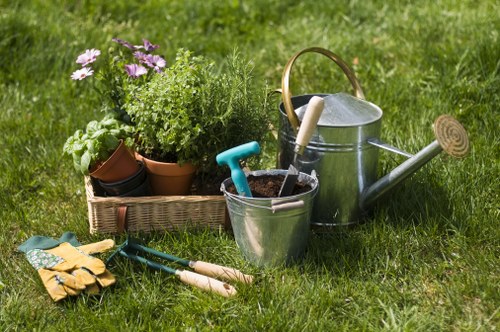Mastering Hedge Trimming in Garden Fencing: A Comprehensive Guide
Introduction to Hedge Trimming

Hedge trimming is an essential aspect of garden maintenance, particularly when it comes to garden fencing. Properly trimmed hedges not only enhance the aesthetic appeal of your garden but also contribute to the overall health and functionality of your fence. In this guide, we'll explore the various facets of hedge trimming in relation to garden fencing, providing you with the knowledge and tools to achieve a beautiful and sustainable garden.
Garden fencing serves multiple purposes, from defining boundaries to providing privacy and security. Integrating well-maintained hedges with your fencing can create a harmonious and inviting outdoor space. Whether you're a seasoned gardener or a novice, understanding the techniques and best practices of hedge trimming is crucial for maintaining both your plants and fencing in optimal condition.
In this article, we'll cover the basics of hedge trimming, the tools you'll need, step-by-step trimming processes, and tips for maintaining healthy hedges that complement your garden fence. Let's dive in!
Benefits of Regular Hedge Trimming

Regular hedge trimming offers numerous benefits that extend beyond mere appearance. Here are some key advantages:
- Enhanced Aesthetics: Well-trimmed hedges create a neat and organized look, enhancing the overall beauty of your garden and garden fencing.
- Healthier Plants: Trimming removes dead or diseased branches, promoting better air circulation and sunlight exposure, which are vital for plant health.
- Improved Growth: Regular trimming encourages new growth, making your hedges fuller and more vibrant over time.
- Safety: Overgrown hedges can obstruct pathways and create hazards. Trimming ensures clear and safe access around your garden.
Incorporating these practices not only ensures the longevity of your hedges but also maintains the integrity and functionality of your garden fencing.
Essential Tools for Hedge Trimming

Having the right tools is critical for effective hedge trimming. Here's a list of essential equipment you'll need:
- Pruning Shears: Ideal for small branches and precise cuts.
- Hedge Trimmers: Electric or gas-powered trimmers are suitable for larger hedges.
- Loppers: Useful for thick branches that pruning shears can't handle.
- Gloves: Protect your hands from thorns and debris.
- Safety Glasses: Shield your eyes from flying particles.
- Ladder: Necessary for reaching higher sections of tall hedges.
Investing in quality tools will make the trimming process more efficient and reduce the risk of injury.
Step-by-Step Guide to Trimming Hedges

1. Assess the Hedge and Fence
Before you begin trimming, evaluate the current state of your hedges and garden fencing. Identify any damaged branches, uneven growth, or areas that require extra attention. Understanding the relationship between your hedges and fence will help you plan your trimming approach effectively.
2. Plan Your Trim
Decide on the shape and size you want your hedges to achieve. Whether you prefer a formal look with straight lines or a more natural appearance, having a clear plan will guide your trimming process.
3. Start Trimming
Begin trimming from the bottom, working your way up. This approach helps maintain balance and ensures that all sections receive adequate attention. Use pruning shears for smaller branches and hedge trimmers for larger areas.
4. Maintain Consistent Shape
Ensure that both sides of the hedge are symmetrical. Consistency in shape enhances the visual appeal and complements the structure of your garden fencing.
5. Clean Up
After trimming, remove all cut branches and debris from the area. This step prevents the buildup of pests and disease, promoting a healthier environment for your hedges and fence.
Best Practices for Maintaining Healthy Hedges

Maintaining healthy hedges requires ongoing care and attention. Here are some best practices to follow:
- Regular Trimming: Trim your hedges at least twice a year to keep them in good shape and prevent overgrowth.
- Proper Watering: Ensure your hedges receive adequate water, especially during dry periods. However, avoid overwatering, which can lead to root rot.
- Fertilizing: Apply a balanced fertilizer to promote healthy growth and vibrant foliage.
- Pest Control: Monitor your hedges for signs of pests or diseases and address them promptly to prevent spread.
- Mulching: Apply mulch around the base of your hedges to retain moisture and suppress weed growth.
Implementing these practices will ensure that your hedges remain lush, green, and well-integrated with your garden fencing.
Integrating Hedges with Garden Fencing Styles
Garden fencing comes in various styles, and integrating hedges seamlessly can elevate the overall design of your outdoor space. Here are some popular fencing styles and tips on how to complement them with hedges:
1. Traditional Wooden Fencing
Pairing wooden fences with hedges like boxwood or privet creates a classic and timeless look. Regular trimming ensures that the hedges form a natural barrier while highlighting the elegance of wooden panels.
2. Modern Metal Fencing
For a contemporary aesthetic, use hedges with sleek, architectural shapes such as Leylandii or Italian cypress. These hedges add green contrast to the metallic finish, creating a balanced and stylish appearance.
3. Wrought Iron Fencing
Wrought iron fences with ornate designs can be softened with lush hedges like holly or laurel. The dense foliage contrasts beautifully with the intricate patterns of the metal, adding depth and interest to your garden.
4. Picket Fencing
Picket fences are perfect for cottage gardens. Opt for semi-formal hedges like yew or boxwood to maintain a whimsical and charming atmosphere.
5. Vinyl Fencing
Vinyl fences are versatile and complement a wide range of hedges. Consider low-maintenance options like arborvitae or crepe myrtle to keep your garden looking pristine with minimal effort.
Seasonal Hedge Trimming Tips
Different seasons require different trimming techniques to ensure your hedges remain healthy and vibrant throughout the year.
Spring Trimming
In spring, focus on removing any winter damage and shaping your hedges before the growing season begins. This helps promote new growth and establishes a defined structure.
Summer Trimming
Summer trimming involves light maintenance to control the size and shape of your hedges. Remove any stray branches and ensure adequate airflow to prevent overheating.
Autumn Trimming
Autumn is the perfect time to perform a more substantial trim, preparing your hedges for the dormant winter months. Clear out any fallen leaves and prune back any overgrown sections.
Winter Trimming
While most hedges are dormant in winter, some species can benefit from light trimming. Focus on removing dead or diseased branches to maintain the health of your plants.
Year-Round Maintenance
Regardless of the season, regular inspections and minor adjustments are necessary to keep your hedges and garden fencing in top condition.
Common Mistakes to Avoid
Avoiding common hedge trimming mistakes can save you time and ensure the longevity of your plants and fencing.
- Over-Trimming: Cutting back too much can stress your hedges and inhibit healthy growth.
- Incorrect Timing: Trimming at the wrong time of year can disrupt the natural growth cycle of your hedges.
- Using Dull Tools: Dull blades can cause jagged cuts, increasing the risk of disease and pest infestation.
- Ignoring Health Issues: Failing to address pests or diseases can lead to severe damage and affect your garden fencing.
- Improper Shaping: Neglecting symmetry and balance can result in an unkempt appearance.
By being aware of these pitfalls, you can maintain healthy hedges that enhance the beauty and functionality of your garden fencing.
Sustainable Practices for Hedge Trimming
Adopting sustainable practices in hedge trimming not only benefits your garden but also the environment.
Use Eco-Friendly Tools
Opt for manual or electric trimmers instead of gas-powered ones to reduce your carbon footprint. Regularly maintain your tools to ensure they operate efficiently and last longer.
Compost Trimmings
Instead of disposing of hedge clippings, compost them to create nutrient-rich soil for your garden. This practice reduces waste and promotes sustainability.
Choose Native Plants
Select native hedge species that are well-adapted to your local climate and soil conditions. Native plants require less water and are more resistant to pests and diseases.
Minimize Chemical Use
Limit the use of chemical fertilizers and pesticides. Instead, use organic alternatives to maintain healthy hedges without harming beneficial insects and soil microorganisms.
Water Conservation
Implement efficient watering techniques, such as drip irrigation, to minimize water waste and ensure your hedges receive adequate moisture.
Professional Hedge Trimming Services
If maintaining your hedges becomes overwhelming, consider hiring professional hedge trimming services. Experts offer various benefits:
- Expertise: Professionals have the knowledge and experience to trim your hedges correctly, ensuring their health and aesthetic appeal.
- Time-Saving: Outsourcing hedge trimming allows you to focus on other aspects of garden maintenance or enjoy your outdoor space.
- Proper Equipment: Professionals use specialized tools that may not be available to the average gardener, ensuring efficient and precise trimming.
- Safety: Trimming tall or thick hedges can be dangerous. Professionals have the necessary safety equipment and training to perform the job safely.
When selecting a service, look for reputable providers with positive reviews and a portfolio of completed projects.
Conclusion
Hedge trimming in garden fencing is a crucial task that enhances the beauty, health, and functionality of your outdoor space. By following the guidelines and best practices outlined in this article, you can maintain stunning hedges that complement your garden fencing and create a welcoming environment.
Remember to invest in the right tools, adhere to a regular trimming schedule, and adopt sustainable practices to ensure your hedges remain vibrant and resilient. Whether you choose to undertake the task yourself or hire professionals, prioritizing hedge trimming will yield long-term benefits for your garden.
Contact us today to learn more about our gardening services or book your service now to transform your garden with expertly trimmed hedges and pristine fencing.